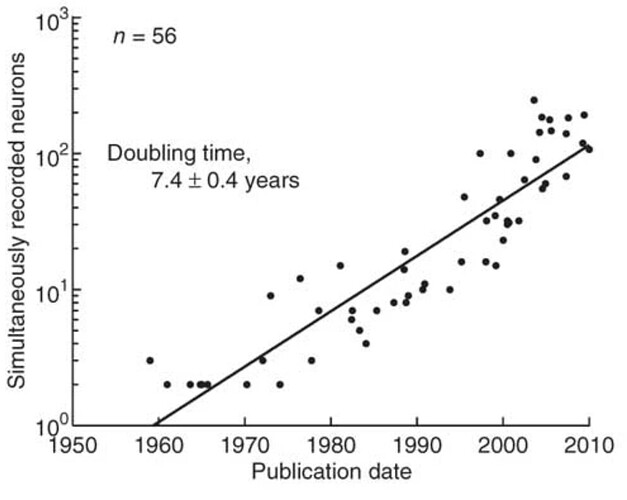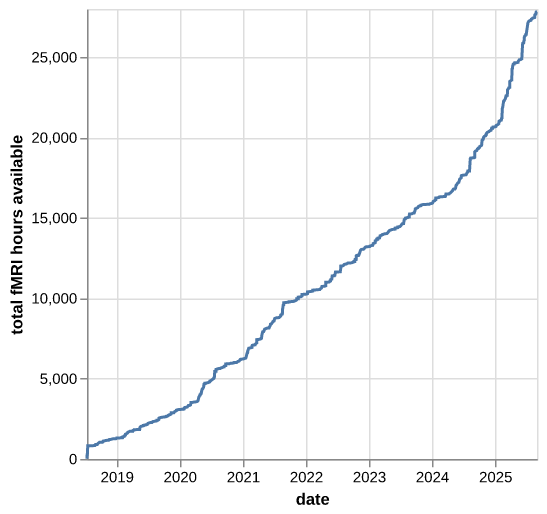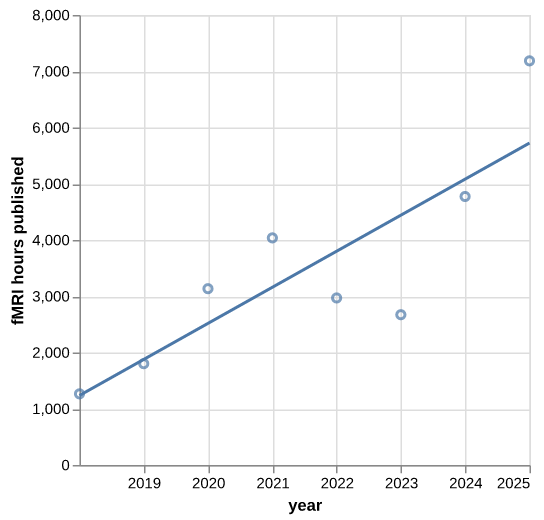name nb_subjects has_participant_tsv has_participant_json participant_columns has_phenotype_dir datatypes sessions tasks size authors institutions raw fmriprep freesurfer mriqc
ds000001 16 True False ['participant_id', 'sex', 'age'] False ['anat', 'func'] [] ['balloonanalogrisktask'] 2.2 GB ['Tom Schonberg', 'Christopher Trepel', 'Craig Fox', 'Russell A. Poldrack'] [] https://github.com/OpenNeuroDatasets/ds000001 https://github.com/OpenNeuroDerivatives/ds000001-fmriprep n/a https://github.com/OpenNeuroDerivatives/ds000001-mriqc
ds000002 17 True False ['participant_id', 'sex', 'age'] False ['anat', 'func'] [] ['deterministicclassification', 'mixedeventrelatedprobe', 'probabilisticclassification'] 2.7 GB ['Aron, A.R.', 'Gluck, M.A.', 'Poldrack, R.A.'] [] https://github.com/OpenNeuroDatasets/ds000002 https://github.com/OpenNeuroDerivatives/ds000002-fmriprep n/a https://github.com/OpenNeuroDerivatives/ds000002-mriqc
ds000003 13 True False ['participant_id', 'sex', 'age'] False ['anat', 'func'] [] ['rhymejudgment'] 394.2 MB ['Xue, G.', 'Russell A. Poldrack'] [] https://github.com/OpenNeuroDatasets/ds000003 n/a n/a https://github.com/OpenNeuroDerivatives/ds000003-mriqc
ds000005 16 True False ['participant_id', 'sex', 'age'] False ['anat', 'func'] [] ['mixedgamblestask'] 1.8 GB ['Tom S.M.', 'Fox C.R.', 'Trepel C.', 'Poldrack R.A.'] [] https://github.com/OpenNeuroDatasets/ds000005 https://github.com/OpenNeuroDerivatives/ds000005-fmriprep n/a https://github.com/OpenNeuroDerivatives/ds000005-mriqc
ds000006 14 True False ['participant_id', 'sex', 'age'] False ['anat', 'func'] ['retest', 'test'] ['livingnonlivingdecisionwithplainormirrorreversedtext'] 4.4 GB ['K Jimura', 'E Stover', 'F Cazalis', 'Russell A. Poldrack'] [] https://github.com/OpenNeuroDatasets/ds000006 n/a n/a https://github.com/OpenNeuroDerivatives/ds000006-mriqc
ds000007 20 True False ['participant_id', 'gender', 'age'] False ['anat', 'func'] [] ['stopmanual', 'stopvocal', 'stopword'] 3.4 GB ['Xue G', 'Aron AR', 'Russell A. Poldrack'] [] https://github.com/OpenNeuroDatasets/ds000007 n/a n/a https://github.com/OpenNeuroDatasets/ds000007/tree/main/derivatives/mriqc
ds000008 14 True False ['participant_id', 'sex', 'age'] False ['anat', 'func'] [] ['conditionalstopsignal', 'stopsignal'] 2.0 GB ['Aron, A.R.', 'Behrens, T.E.', 'Frank, M.', 'Smith, S.', 'Poldrack, R.A.'] [] https://github.com/OpenNeuroDatasets/ds000008 https://github.com/OpenNeuroDerivatives/ds000008-fmriprep n/a https://github.com/OpenNeuroDerivatives/ds000008-mriqc
ds000009 24 True False ['participant_id', 'age', 'sex', 'm_SSRTquant', 'm_NumPumps_Avg', 'm_TotalAmt_Avg', 'm_NumExplAvg', 'm_logit_k', 'm_AN-SN', 'b_SSRTquant', 'b_NumPumps_Avg', 'b_TotalAmt_Avg', 'b_NumExplAvg', 'b_k', 'b_AN-SN', 'GABS_TOTAL', 'CARE_ENGAGING-DRUG', 'CARE_ENGAGING-AGGR/ILLEG', 'CARE_ENGAGING-SEX', 'CARE_ENGAGING-DRINKING', 'CARE_ENGAGING-SPORTS', 'CARE_ENGAGING-TOTAL', 'CARE_NEGCONS-DRUG', 'CARE_NEGCONS-AGGR/ILLEG', 'CARE_NEGCONS-SEX', 'CARE_NEGCONS-DRINKING', 'CARE_NEGCONS-SPORTS', 'CARE_NEGCONS-TOTAL', 'CARE_POSCONS-DRUG', 'CARE_POSCONS-AGGR/ILLEG', 'CARE_POSCONS-SEX', 'CARE_POSCONS-DRINKING', 'CARE_POSCONS-SPORTS', 'CARE_POSCONS-TOTAL', 'NEED', 'FOR', 'COG_TOTAL', 'COG', 'REFLECTION_NUM', 'CORR', 'COG.1', 'REFLECTION_CONFIDENCE', 'COG.2', 'REFLECTION_NUM.1', 'SEEN', 'SENS', 'SEEK_BOREDOM', 'SENS.1', 'SEEK_DISINHIB', 'SENS.2', 'SEEK_EXP', 'SEEK', 'SENS.3', 'SEEK_THRILL', 'SEEK.1', 'SENS.4', 'SEEK_TOTAL', 'BIS_ATTN', 'BIS_MOTOR', 'BIS_NP', 'BIS_TOTAL', 'BIS/BAS_BAS-REWRESP', 'BIS/BAS_BAS-FUNSEEK', 'BIS/BAS_BAS-DRIVE', 'BIS/BAS_BAS', 'TOTAL', 'BIS/BAS_BIS', 'DOSPERT_RT-ETH', 'DOSPERT_RT-FIN', 'DOSPERT_RT-HLTH/SAF', 'DOSPERT_RT-REC', 'DOSPERT_RT-SOC', 'DOSPERT_RT-TOTAL', 'DOSPERT_RP-ETH', 'DOSPERT_RP-FIN', 'DOSPERT_RP-HLTH/SAF', 'DOSPERT_RP-REC', 'DOSPERT_RP-SOC', 'DOSPERT_RP-TOTAL', 'DOSPERT_EB-ETH', 'DOSPERT_EB-FIN', 'DOSPERT_EB-HLTH/SAF', 'DOSPERT_EB-REC', 'DOSPERT_EB-SOC', 'DOSPERT_EB-TOTAL', 'PANAS_(Post-Pre)-Interested', 'PANAS_(Post-Pre)-Distressed', 'PANAS_(Post-Pre)-Excited', 'PANAS_(Post-Pre)-Upset', 'PANAS_(Post-Pre)-Strong'] False ['anat', 'dwi', 'func'] [] ['balloonanalogrisktask', 'discounting', 'emotionalregulation', 'stopsignal'] 6.1 GB ['Jessica Cohen', 'Russell A. Poldrack'] [] https://github.com/OpenNeuroDatasets/ds000009 https://github.com/OpenNeuroDerivatives/ds000009-fmriprep n/a https://github.com/OpenNeuroDerivatives/ds000009-mriqc
ds000011 14 True False ['participant_id', 'sex', 'age'] False ['anat', 'func'] [] ['Classificationprobewithoutfeedback', 'Dualtaskweatherprediction', 'Singletaskweatherprediction', 'tonecounting'] 2.3 GB ['Foerde, K.', 'Knowlton, B.J.', 'Russell A. Poldrack'] [] https://github.com/OpenNeuroDatasets/ds000011 n/a n/a https://github.com/OpenNeuroDerivatives/ds000011-mriqc
ds000017 8 True False ['participant_id', 'sex', 'age'] False ['anat', 'func'] ['timepoint1', 'timepoint2'] ['probabilisticclassification', 'selectivestopsignaltask'] 2.4 GB ['Rizk-Jackson', 'Aron',
This file has been truncated. show original


